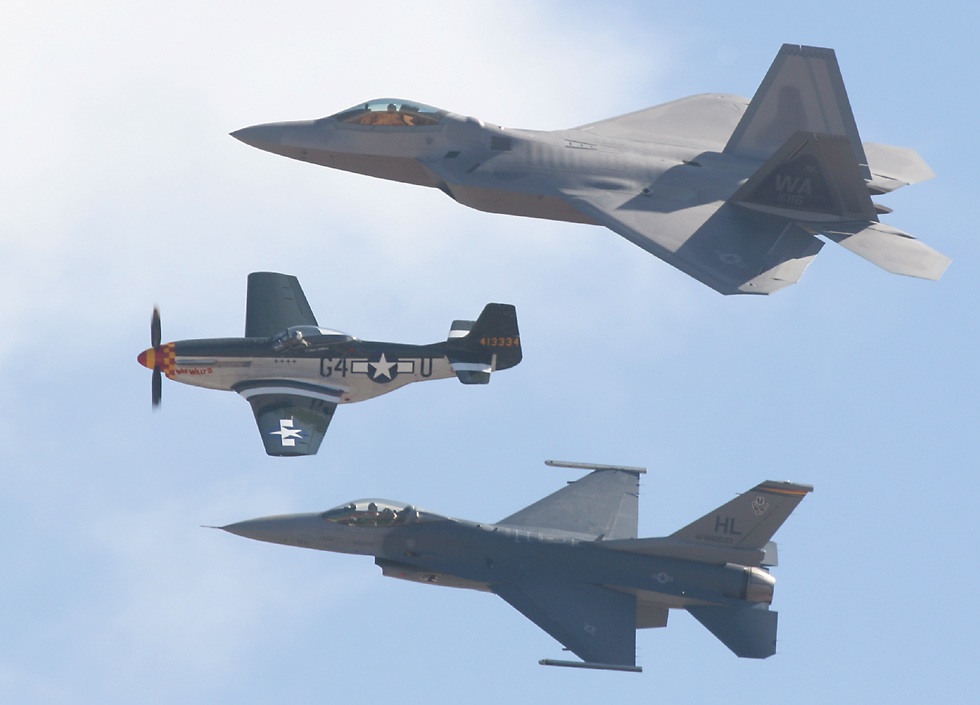Highlights of the 2008 Miramar Airshow
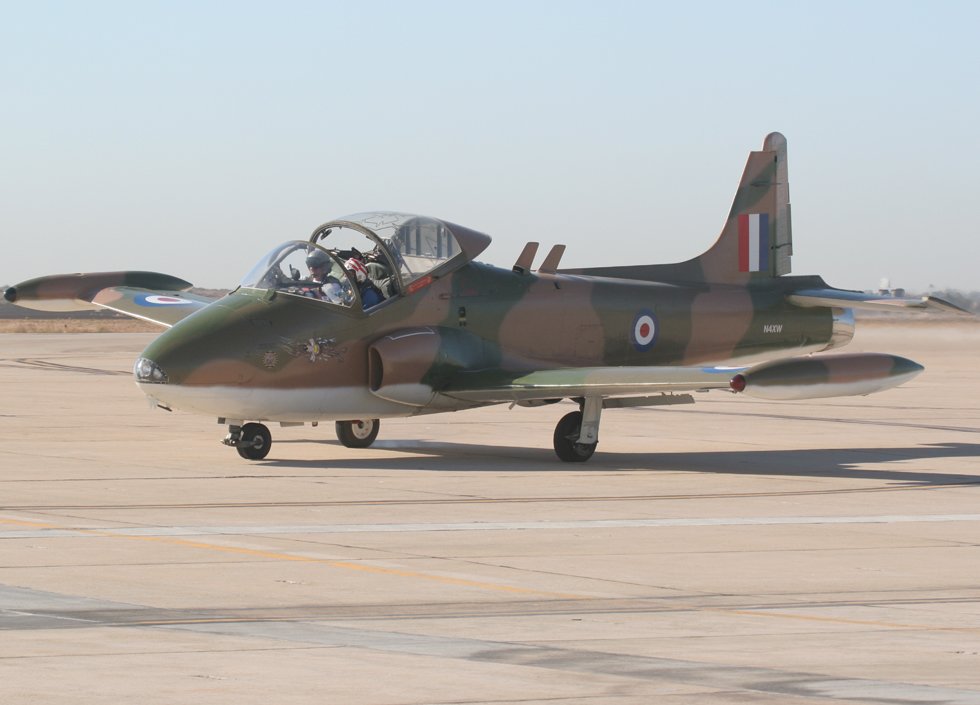
Several interesting aircraft came in on arrivals day, including this Jet Provost trainer still in its original Royal Air Force color scheme, though I suspect the graphic of Wile E. Coyote being sucked into the engine is a later addition. The Jet Provost is a particular favorite of mine because it was the basis of a ground attack aircraft called the Strikemaster, which was exported to many countries in Africa, the Middle East, Asia and even South America. They were used in combat on a number of occasions in the strike role. For many years New Zealand operated Strikemasters alongside their A-4 Skyhawks; the Strikemasters were painted very much like the aircraft you see here, except they had black noses to reduce glare. |
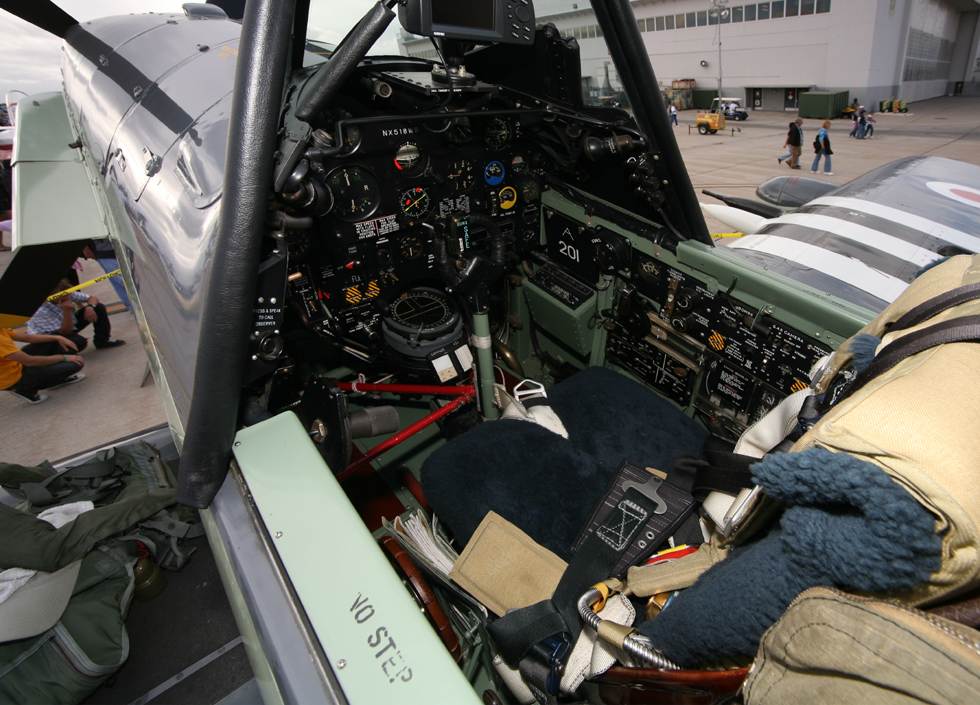
To my regret, the Jet Provost didn't fly during the show but it went on static display, as did this Fairey Firefly owned by Captain Eddie Kurdziel. The Firefly is a little known British naval fighter of world war two. Although not particularly fast, it's extremely maneuverable and very heavily armed, and in addition to its air-to-air role, it also performed well in anti-shipping and ground attack duties. Although it didn't fly at Miramar, you can see some nice shots of this sole survivor of the type taking off during the 2007 Nellis airshow, and strafing during the 2006 Nellis airshow. |
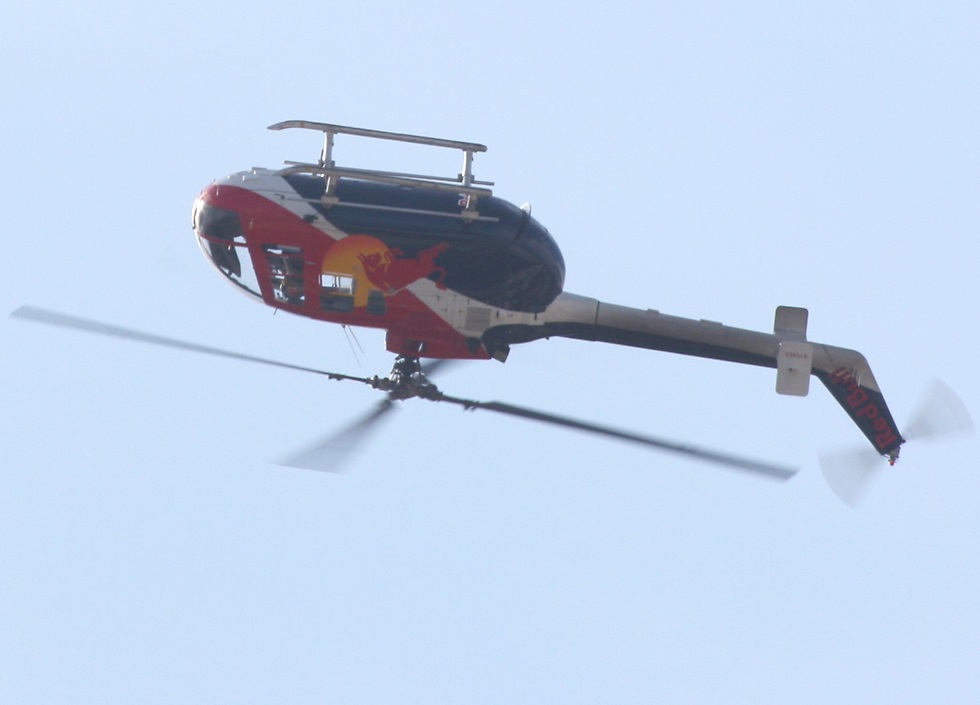
Each year the organizers of the show invite several aerobatic acts to the show, this year it was the turn of Ed Hamill in his Air Force Reserve Pitts biplane, Hartley Folstad and Margi Stivers doing a wing-walking routine in their rather more vintage Stearman biplane and John Collver doing his classic graceful display in his T-6 Texan called "war dog". Of course Sean Tucker was also there, together with his son Eric. Sean did his usual world-class solo act (as he did at the 2007 Nellis airshow), and also flew alongside Eric in a co-ordinated display of loops and other maneuvers. However, in the area of loops it was probably the Red Bull Bo-105 helicopter which had the crowd most on the edge of their seats, wondering how it was even possible for a helicopter to do what they were seeing. |
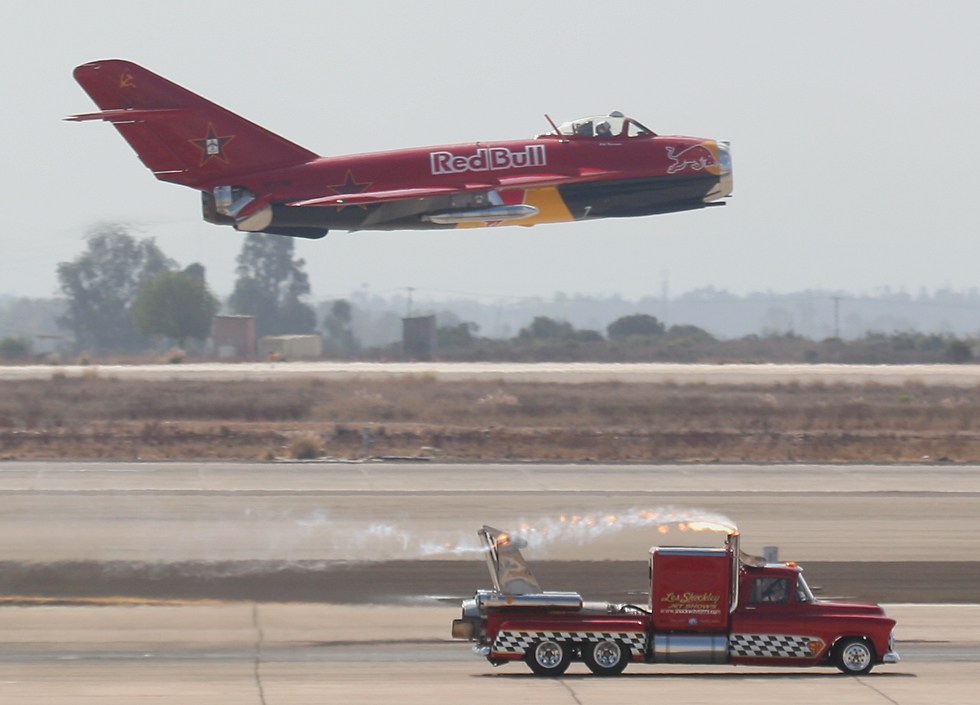
Every year the Miramar airshow organizers have at least one novelty act, for the last few years they've had Les Shockley's jet powered trucks doing their party tricks. Yes, you heard right - these trucks are powered by genuine jet engines, complete with afterburners! The "Shockwave" is a big rig with three engines, but this year he brought along the smaller "Super Shockwave" 1957 Chevy truck, which has "only" two jet engines at the rear. The trucks do a very loud and impressive night show, complete with huge clouds of white smoke and 80 foot flames out the back of the engines, as he dumps raw fuel into the jet blast. And all of this is before the high-speed run, which ends with drag chutes deployed so he can stop before the runway ends! To add to the novelty value, Les usually "races" against Bill Reeseman in the Red Bull MiG-17 jet fighter and somehow always seems to win! I guess that no-one has ever advised Bill not to deploy his speed brakes when he races. |
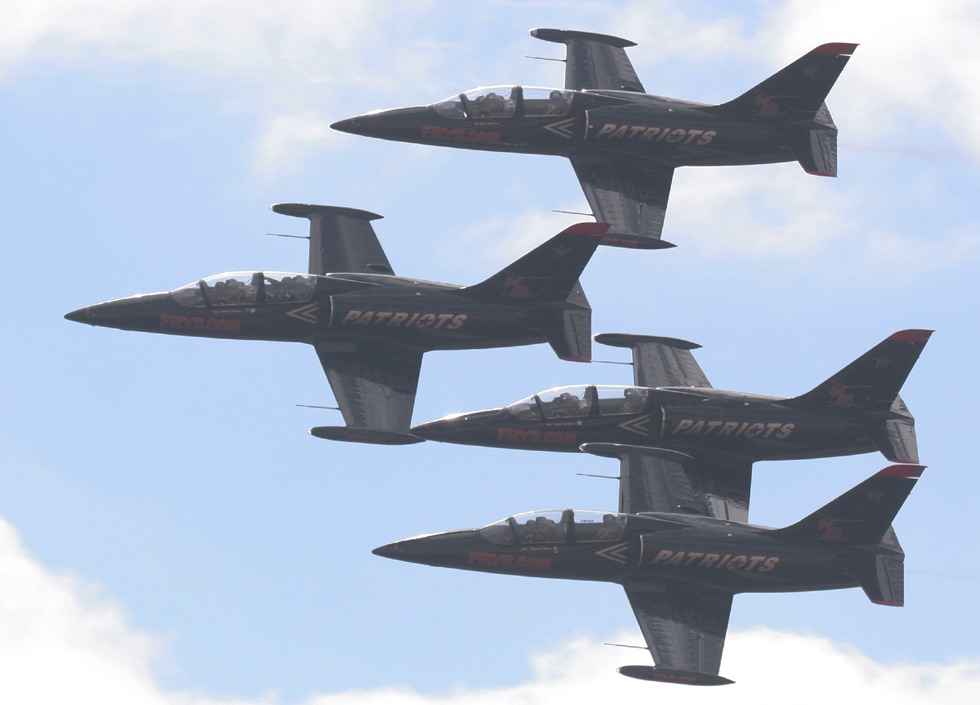
Red Bull also had a MiG-15 "Fagot" jet fighter on static display, and they weren't the only ex-Soviet jets at the show. The "Patriots" jet team, sponsored by Fry's Electronics, operates four Czech designed L-39 Albatroses, which are the standard jet trainer for Russia and other former Soviet bloc countries. The Albatros is a very attractive and functional aircraft which has become very popular in the United States with warbird enthusiasts who have that amount of money to drop on their toys. The Patriot team does an excellent display, including maneuvers done by no other military or civilian team in America, such as the tail slide, in which the aircraft hangs vertically in the air and then starts falling backwards towards the earth, until the pilot recovers and points the nose back in the right direction! |
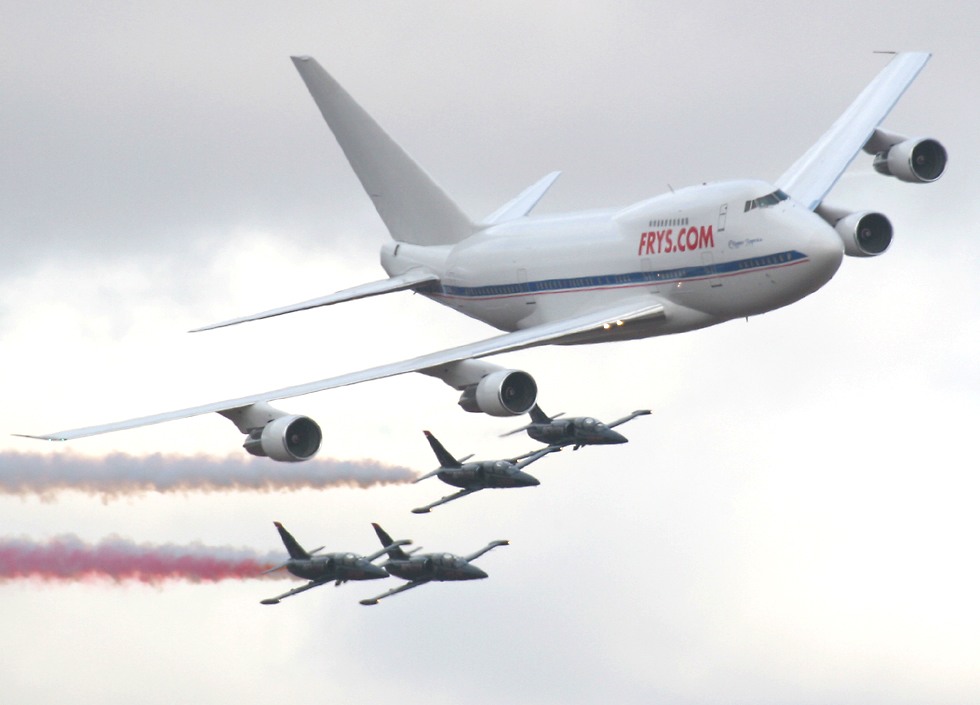
If like Mr Fry you're very successful financially then it's just not enough to sponsor a jet team - you start to feel a hankering to have a jet or two to call your very own! Not only does he have a small corporate jet in the form of an ex-military T-39 Saberliner, he also has his own 747 airliner! And as you can see, if you're spending that much money then it's also your prerogative to fly in formation with your jet team! |
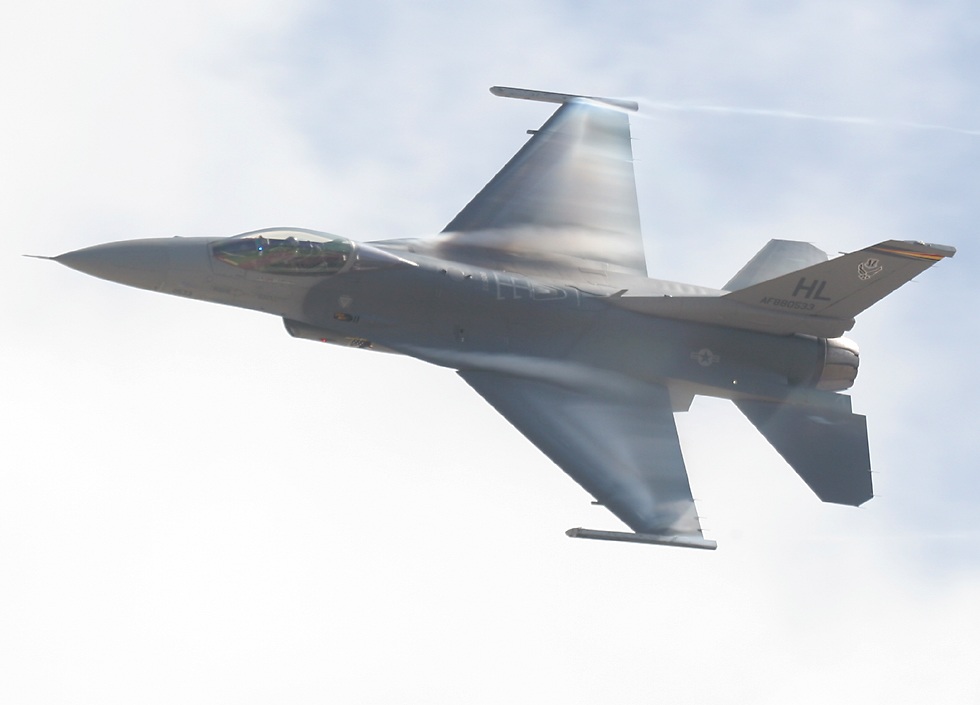
Miramar has a good roster of civilian acts, but it's mostly dominated by modern military equipment. Although this is a marine corps air station, the air force is also invited along, and they took the opportunity to display the F-16 Fighting Falcon, which is the backbone of America's fighter force, and in some ways even more capable than its big brother, the F-15 Eagle. One area in which the F-16 doesn't usually excel is the production of vapor, but conditions this year were ideal and the whole tops of the wings were covered as the Fighting Falcon made its high speed passes. |
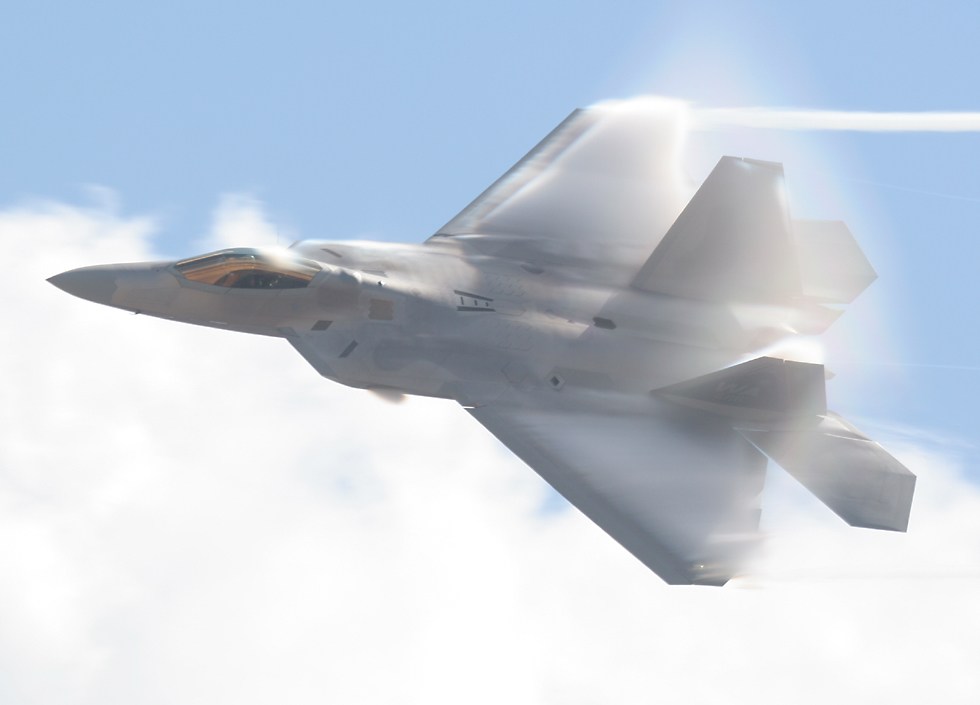
The F-15 isn't noted for the amount of vapor it pulls, but its successor, the F-22 Raptor, has proven itself a real VaporMeister! At Miramar it certainly demonstrated this capability, though not quite so much as at the 2007 Point Mugu airshow, where it sometimes vanished entirely in a thick cloud of its own making. It's no wonder that that airshow is now commonly referred to in the aviation enthusiast community as Vaporfest 07! |
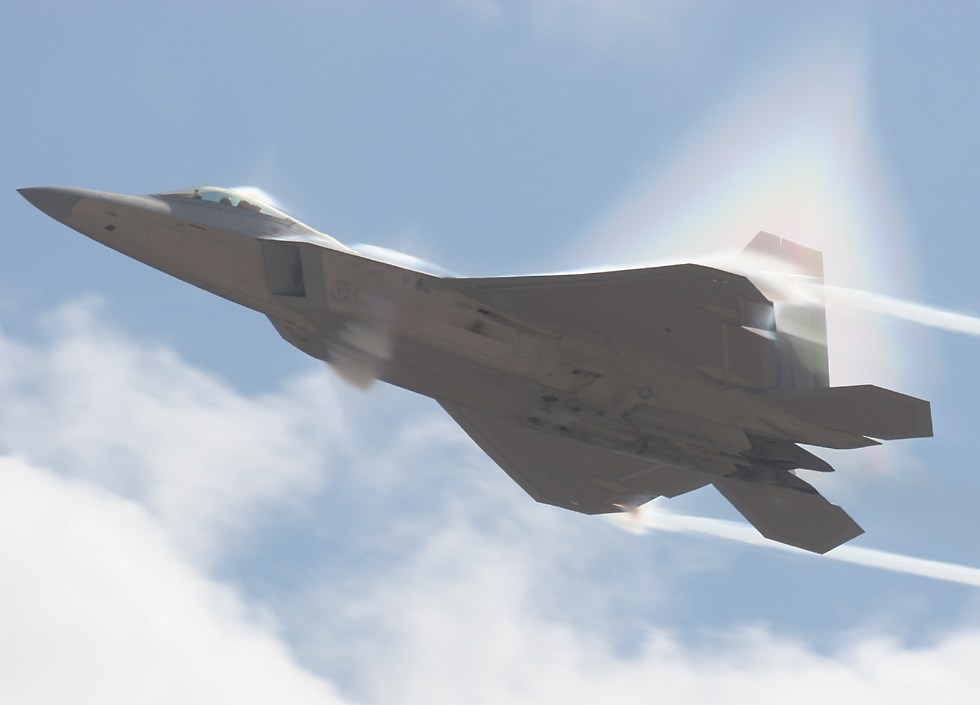
The lighting conditions at Miramar are far from ideal for photographers, but one bonus is the potential for rainbow effects as the sun starts to descend in the west. This shot doesn't just have the rainbow effect, you can also see a triangular shock wave below the vapor which has formed underneath the engine intakes. |
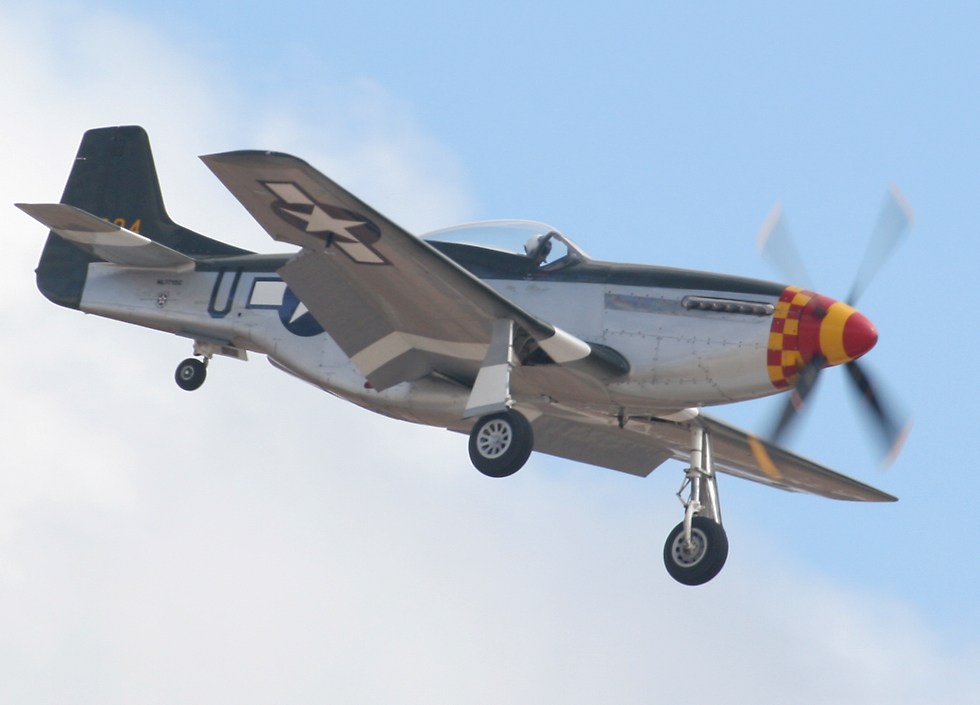
Miramar definitely isn't one of the great shows as far as classic warbirds are concerned, but Steve Hinton's P-51D Mustang called Wee Willy II came down from Chino for the event. |
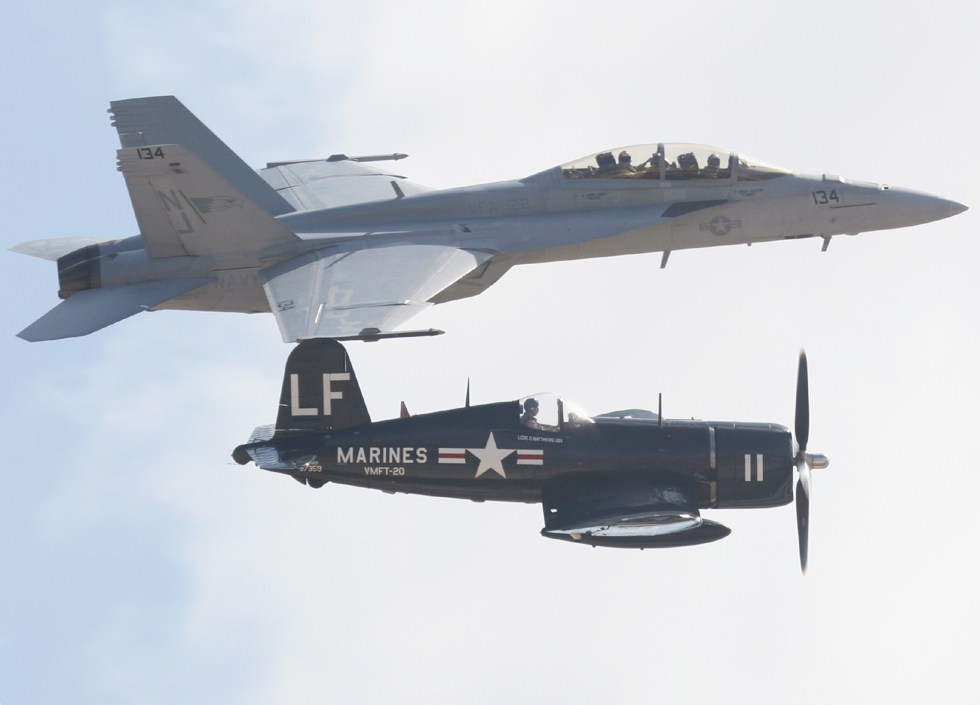
Of course the navy doesn't like to be left out of the game, so they started up their own program of Tailhook Legacy Flights. Here we have a world war two F4U Corsair beautifully matched alongside the navy's current top of the line fighter, the F-18F Super Hornet. |

It's always great to see formations of military aircraft, like these three F-18 "legacy" Hornets, consisting of two single seat F-18Cs and a two seat F-18D. The legacy Hornet is significantly smaller than the Super Hornet, it also has shorter range and less ability to carry ordnance, but surprisingly it's somewhat faster, not that that's generally a battle-winning capability - contrary to popular imagination, very little combat ever occurs at supersonic speeds. |
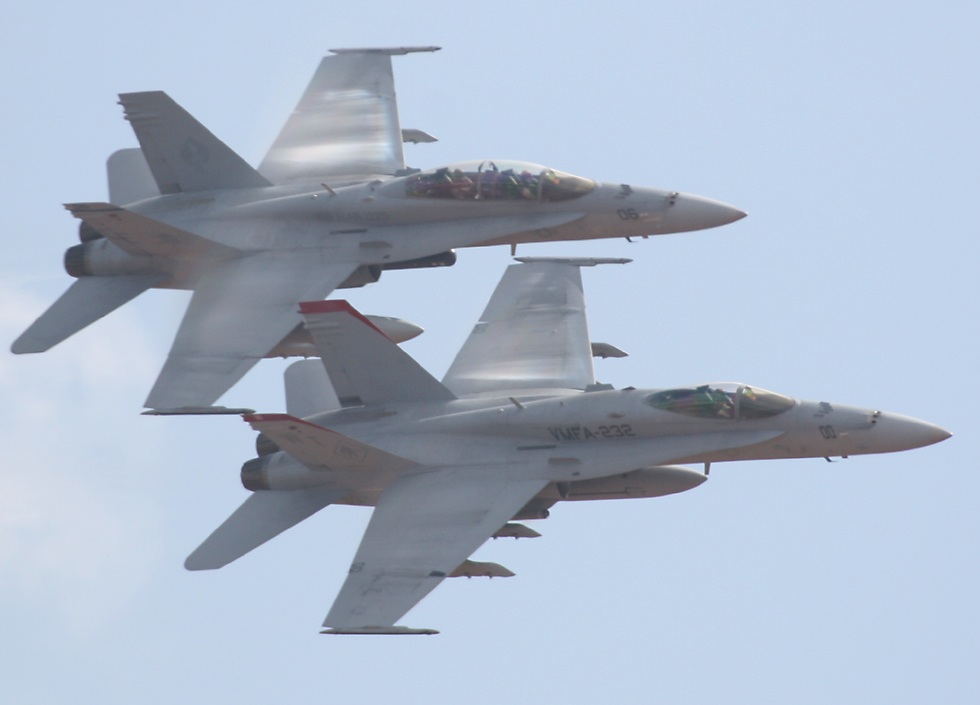
An early version of the Hornet was in competition with the Fighting Falcon when the air force was evaluating which aircraft to field alongside the Eagle. Usually the loser from those competitions fades into oblivion, but the navy liked the twin-engine Hornet so much that they decided to adopt it alongside their top-end fighter, the F-14 Tomcat. The F-18 eventually took over from the F-14 when it was retired, but the F-16 continues to live in the shadow of the F-15 and the ultra-capable F-22. |
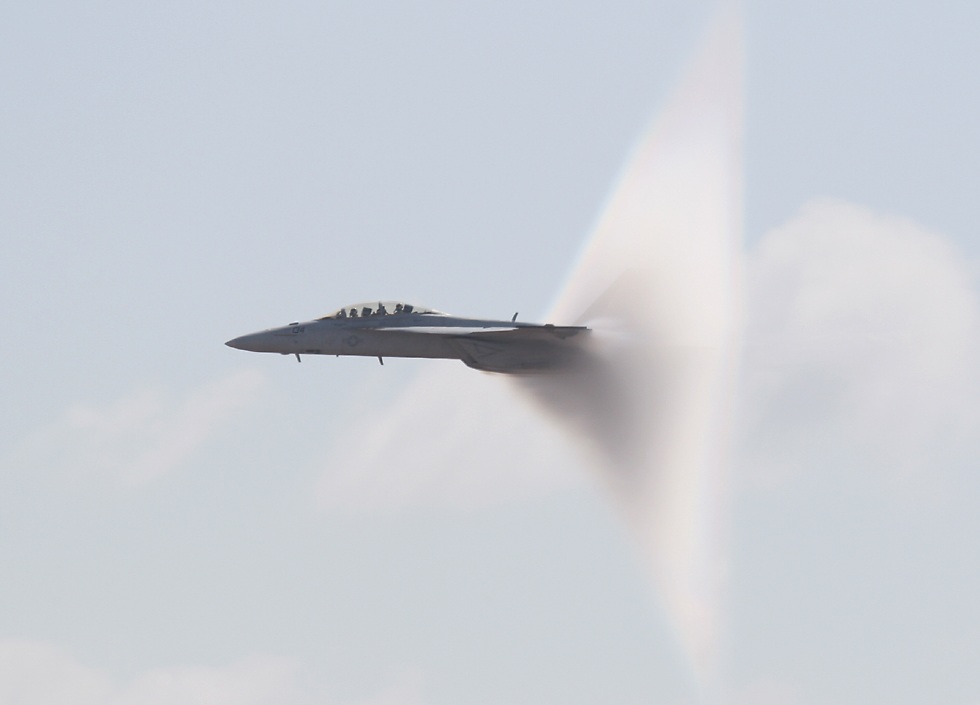
And the Hornet has the capability that really matters - to produce vapor! This isn't just a fluke, either - you can see another F-18F Super Hornet producing a vapor cone at the 2004 Point Mugu airshow. |
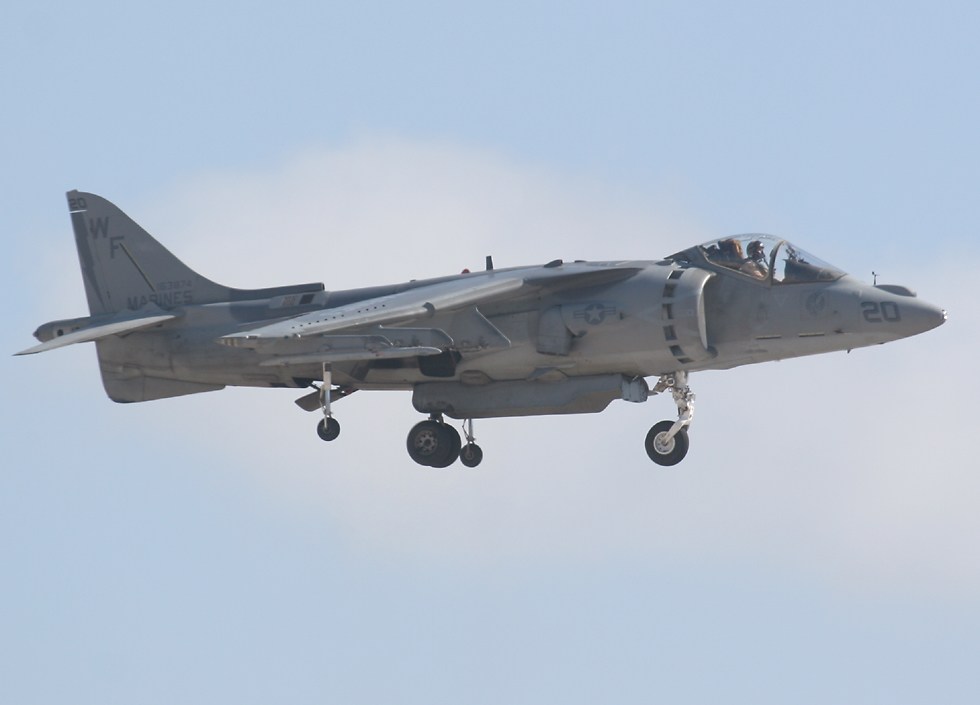
The marine corps also operates the Hornet, but their aircraft of choice is the AV-8B Harrier, an American development of the British Harrier jump jet. The Harrier's short takeoff and landing capability, together with its ability to take off and land entirely vertically, makes it especially suitable for operating from the marine corps' small amphibious assault ships, as well as from rough airfields established near the front lines of a conflict. The Harrier has demonstrated its value both in British and American service, and it's certainly one of the more interesting aircraft in the military arsenal. It's also a great crowd pleaser when it hovers or does vertical takeoffs and landings, though the noise is ear splitting, something which doesn't always endear it to its maintenance crews! |
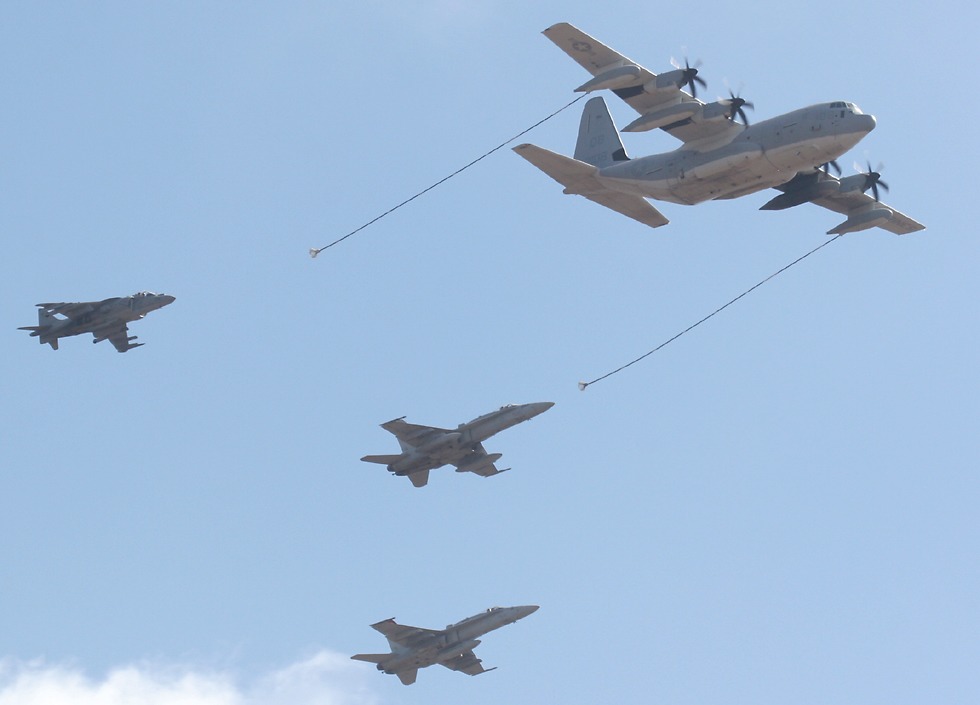
If what you've already seen is all there was at the show, then it would be a very good event - but Miramar has a lot more on display. Miramar is usually the only place anywhere that you can see a public MAGTF demonstration, which is a simulated marine air-ground task force exercise. The MAGTF demonstration involves doing a simulated attack using different marine corps air and ground assets, like this KC-130 aerial tanker with trailing F-18s and AV-8B. |
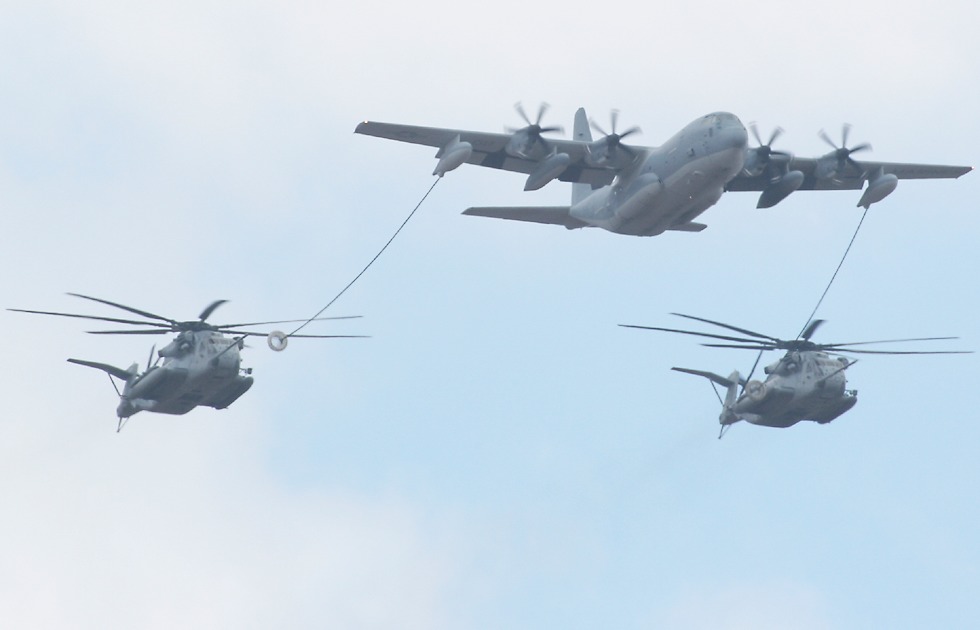
Hornets are a common sight at American airshows, and even Harriers aren't uncommon, but what makes the Mirimar MAGTF special is the involvement of marine corps helicopters. It's rare enough to see any military helicopters at airshows here, and Miramar is unique in both the number and range which are displayed. Here we have a pair of giant CH-53 Sea Stallions, which are America's largest helicopter. As you can see, they have extendable probes so they can take on gas from the KC-130 - one reason that the navy and marines use the "probe and drogue" approach to refuelling in preference to the air force's "flying boom". It's still a tricky operation with that huge rotor spinning overhead, and there's footage on the internet of one Sea Stallion refuelling attempt which ended messily after the aircraft hit some turbulence. After diving downwards, the helicopter pulled back up, but the flexible probe bent so far upwards that it hit the rotors and got cut off. Fortunately the rotor blades didn't disintegrate and since the incident happened over land the pilot was able to safely put the helicopter back on the ground. |

The AH-1W Super Cobra is the marine corps' helicopter gunship, which provides close-in firepower for troops on the ground. In the early 1980s the marine corps requested larger AH-64 Apache gunships like the army, but they were turned down, so they did further development on their existing AH-1T Sea Cobras, and the Super Cobra was the result. Unlike the Sea Cobra, the Super Cobra was able to fire air-to-air sidewinder missiles and air-to-ground hellfire missiles. Another version called the AH-1Z Viper is currently under development, it has four-bladed rotors and slightly longer stub wings, but the same three-barrel 20mm "Gatling gun" cannon with 750 rounds. Iran bought over 200 Super Cobras before the Islamic revolution, and apparently a significant number of these are still flying. They were involved in several aerial battles with Soviet Mi-24 Hind helicopter gunships, but the results of these encounters are in dispute. |

The exhibition included a troop insertion by two CH-46 Sea Knights, which in jarhead parlance are known as Phrogs. Each Sea Knight can carry up to 25 full equipped marines. Like all of the marine corps helicopters, the Sea Knight is a very old design, first flying in the early 1960s. However, it's very reliable and crews like it enough to coin the slogan, "never trust a helicopter under 30". |

The navy retired its last CH-46 in 2004 in favor of the MH-60 Sea Hawk, but the marines will continue to operate theirs until the MV-22 Osprey replaces them. At the same time as the Sea Knights retire, the marines will have to retire another of their slogans, "Phrogs Phorever". |
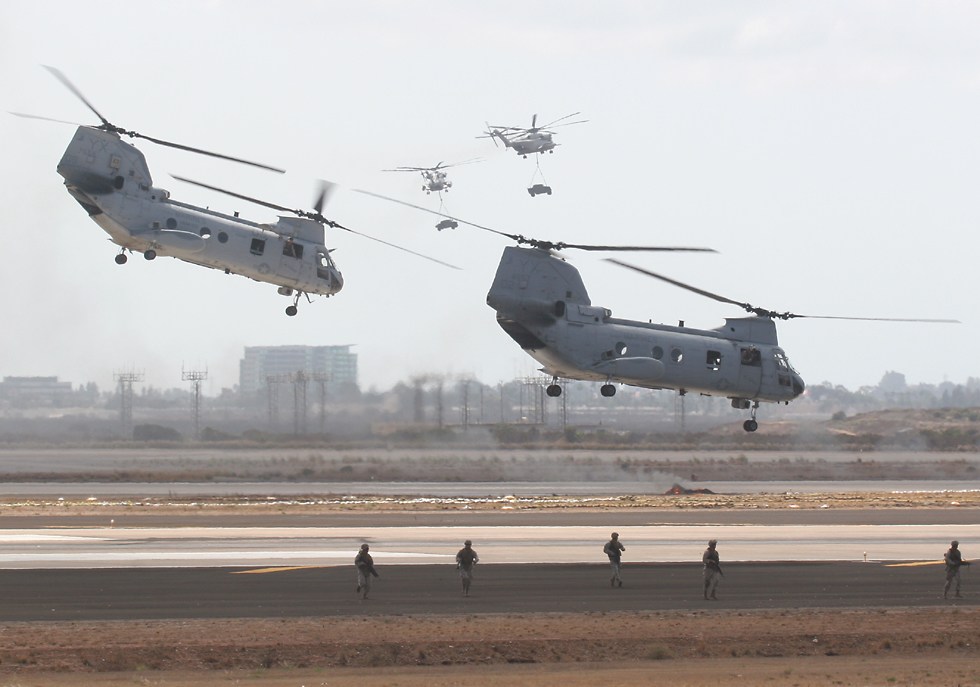
After landing their troops the Phrogs depart from the landing zone, with two Sea Stallions in the background carrying humvees. On the ground below the first Sea Knight you can see smouldering remains of some of the pyrotechnics detonated during the MAGTF display, to simulate supporting fire from naval guns and fixed wing assets like the Hornets and Harriers, which rush through making simulated bombing and strafing runs. |
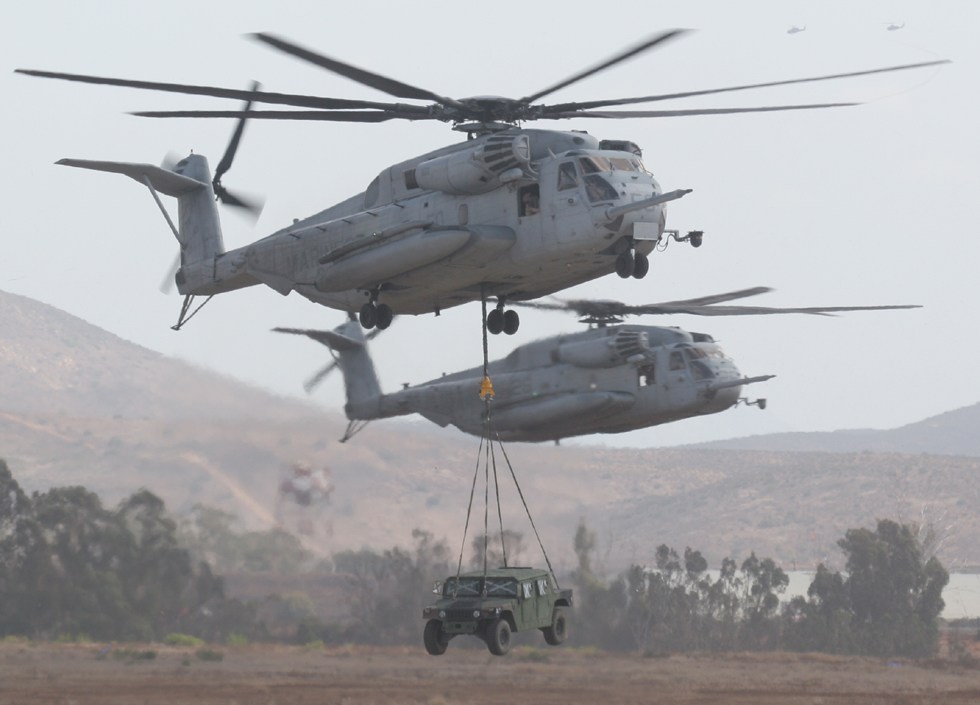
Looks like they must have dropped one of those humvees somewhere! Some years the demonstration includes the setting down of a humvee, other times these big birds bring in a large howitzer, which the troops then man. It's hard to believe, but the rotors and tails on these helicopters actually fold so they can fit more easily onto a carrier; you can see the tail's dark vertical hinge line right where the tail joins the fuselage. |

It's quite a sight seeing no fewer than three Sea Stallions come together in formation in a confusing blur of bodies and rotors! |

As well as aircraft, the demonstration includes ground vehicles like this M1A1 Abrams tank. It might not be obvious, but the Abrams has a lot in common with the marine corps helicopters and fixed wing aircraft - they're all powered by jet engines. But whereas the fixed wing aircraft can mess around with the sound barrier, and the helicopters can all do better than 150mph, the Abrams can't do much more than 45mph on paved surfaces or 30mph on rough ground. One reason the Abrams has so much power and so little speed is its weight, almost 70 tons, making it one of the heaviest tanks in service anywhere. Of course much of that weight comes from armor, which in this case includes areas protected by a layer of depleted uranium. This armor allowed these tanks to survive multiple hits by Iraqi tanks at fairly close range, and even some friendly fire incidents where Abram tanks hit other Abram tanks with their 105mm gun! If you want to buy one, then you should start saving your pennies - the base model costs $2.3 million, and a full-pimped out ride will set you back $4.3 million. |
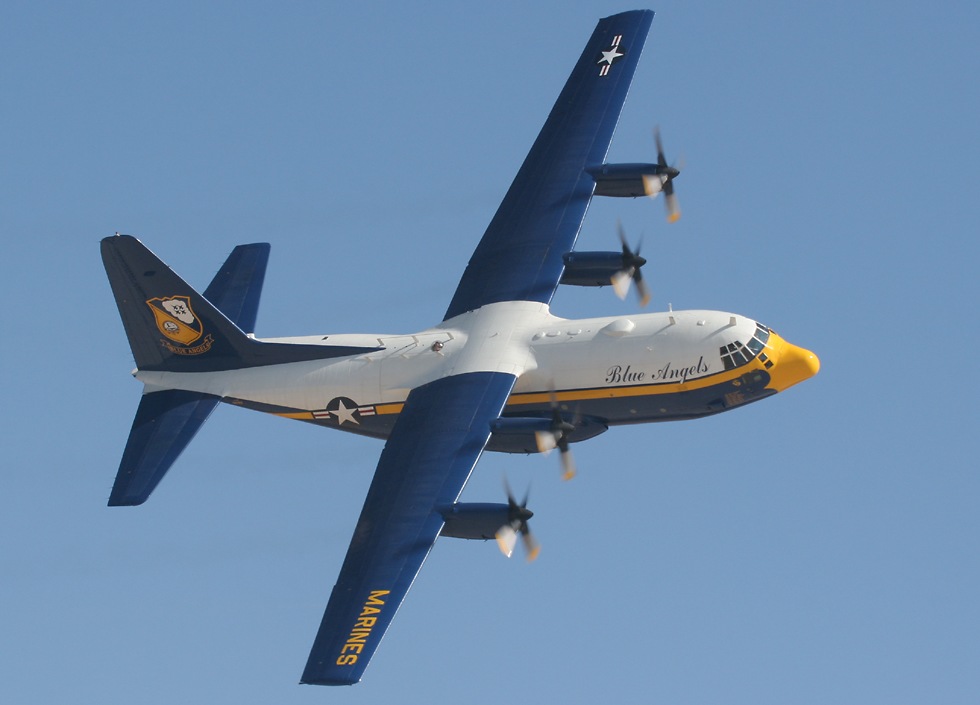
Since Miramar is a marine corps air station, it's traditional for the Blue Angels to close out the performance each day, and that means a demonstration put on by their support aircraft, the C-130 Hercules better known as "Fat Albert". At the Friday evening show, Fat Albert did its trademark rocket-assisted takeoff, and during the daytime shows it did a spirited display with very low pass on takeoff, a very steep "Sarajevo" style runway landing (done rather better that the Italian air force's Sarajevo landings), and fast banked passes in front of the crowd. |
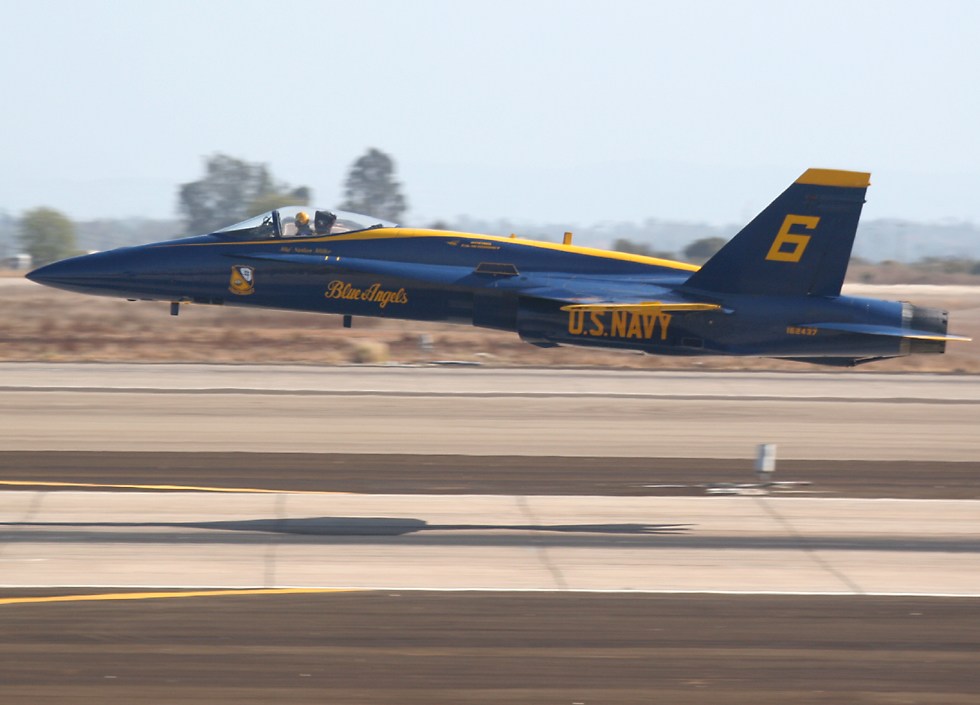
Fat Albert wasn't the only one doing low passes on takeoff, either! Here's Blue Angel number 6, the same one who blocked our view at the start of this page. When he reached the end of the runway, he pointed the nose of his Hornet straight up and headed for the blue! |
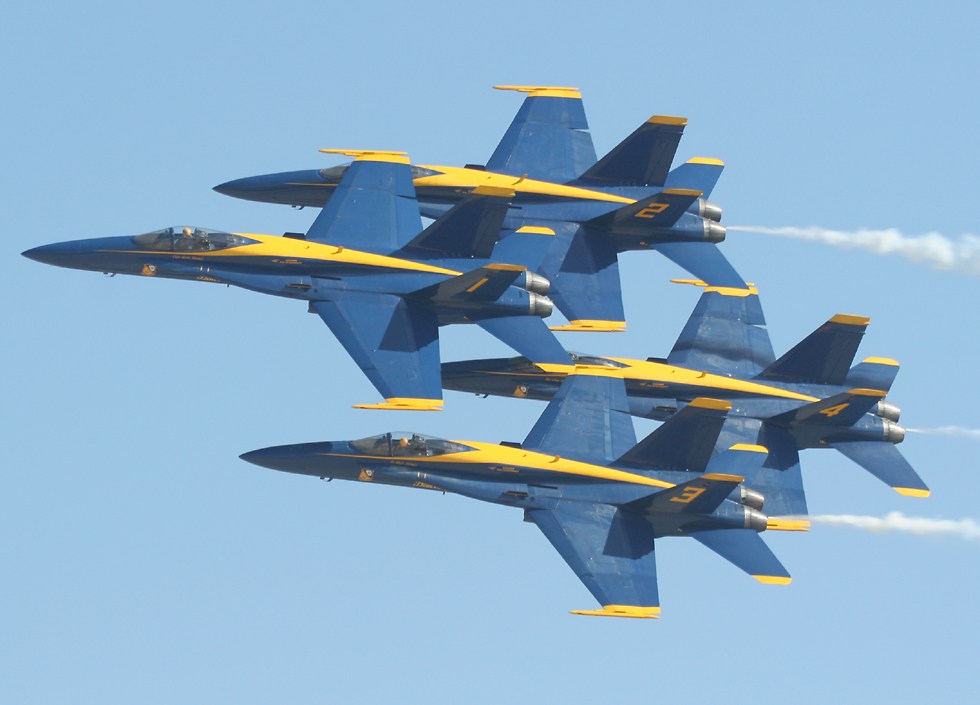
The Blue Angels are probably the best military jet display team in the world, flying closer together than any other, and dazzling the crowd with fast passes, head-on passes and many different types of formation flying. It was a very fitting culmination to a very good show. |


